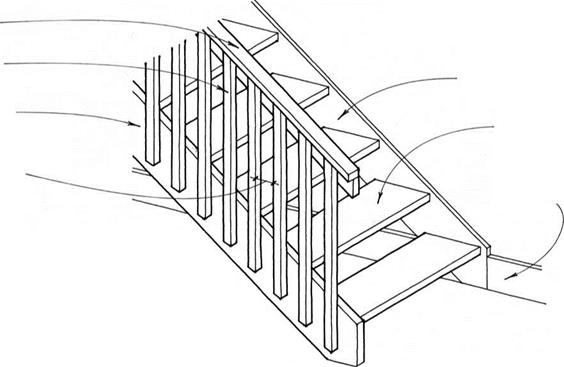Requirements for aggregates to be used in SMA are catalogued in Chapter 5. When differences among densities of aggregates used for composing an SMA aggregate
* 2.36 mm in the United States, 2.0 mm in Europe.
[30] NMAS stands for nominal maximum aggregate size—a sieve one size larger than the first sieve retaining more than 10% of the aggregate.
[31] Fill the container with aggregate up to one third of its height, level the surface of the poured aggregate using your fingers, and then tamp the layer down with 25 strokes of the tamping rod, taking care to evenly distribute the strokes over the surface and avoiding hitting the bottom of the container (Figure 7.7).
[32] Having completed the tamping of the first layer of aggregate, fill the container with a second layer of aggregate—this time up to two thirds of its height—and repeat the tamping procedure.
[33] Calculate the void content in a compacted aggregate according to the formula
[34] In earlier research, other numbers of rotations have been proposed based on Los Angeles (LA) abrasion loss of coarse aggregate—that is, for LA less than 30%, 100 SHRP gyratory compactor (SGC) rotations can be used, and for LA greater than 30%, 70 rotations (Brown and Cooley, 1999).
* We start with number 3 of the first mixture, because the next mixtures will have a different composition based on HDK content (mixes 1 and 2 with decreased HDK content, mixes 4 and 5 with increased HDK content); so the number 3 is virtually in the middle of the series.
[36] It is being adopted based on the experience of a process engineer (e. g., a typical amount for a given gradation). The term optimum is a little bit exaggerated because the truly optimal content will be described later in the text.
[37] The telescope principle is a term used in a paper by Lees (1969) as the layout principle for grains in a mixture in which the finer particles fill in the remaining voids among coarser ones.
[38] For instance, using a small amount of oil with the density at the room temperature corresponding to the density of binder at the temperature of mixing with an aggregate. So an oil with a density of ca. 0.2 Pa. s at 25°C should be used.
[39] In the Netherlands a gyratory compactor is used for such testing because the Marshall hammer is regarded as being excessively damaging to particles making the skeleton, and for that reason not fit to be used for compacting the aggregate with such a strong skeleton.
* 5.0% of air voids is used only for heavy-duty pavements.
f So-called Van der Baan’s number (i. e., the bituminous number after the EN 13179-2).
[41] Binder 70/100 with Pen@25°C from 70 to 100 dmm. Former road bitumen 80/100 after the Dutch standard NEN
§ Obviously it is about quantities of fixed binder and free binder, whose definitions and significance are discussed in Chapter 3.
[42] We start with 200 rotations of a gyratory compactor. Then we determine such a number of rotations that changes the sample height by 0.2% during the last 10 rotations. Density of the mix reached at the selected number of rotations of the gyratory compactor are a reference (maximum) density for calculating the content of air voids in the SMA. (Voskuilen, J. L.M. et al., 2004.)
[43] The bitumen content for SMA 0/8 amounts to 7.4% (m/m) for the heavy-duty traffic and 7.0% (m/m) for low-volume traffic. Both values have been calculated with 100% of the aggregate mass and the road bitumen 70/100 as a standard binder.
[44] The content of air voids in laboratory compacted samples amounts to 5% (v/v).
• The content of air voids in the compacted coarse aggregate fraction amounts to 36.7% (v/v).
• The content of the coarse aggregate fraction in the aggregate mix amounts to 78% (v/v).
• The FRs ratio equals 0.
[45] With a wetting agent.
[46] Calculate the expected SMA void content based on volume properties.
• Gradation of the aggregate
• Voids in a compacted coarse aggregate skeleton
• Binder content
[47] In this book that energy is usually referred to in 2 x A conventional notation, where A denotes the number of impacts on one side of a sample (e. g., 2 x 50 or 2 x 75).
[48] The first experiments with this type of apparatus were performed from 1939 to 1946 by the Texas Highway Department in the United States. More about the history behind the gyrator compactor can be found in Harman et al. (2001).
[49] Laboratoire Central des Ponts et Chaussees, or Central Laboratory for Roads and Bridges, France
[50] The fixed temperature of draindown testing adopted in the original Schellenberg’s method, 170°C, represents an average SMA production temperature for a typical mix with binder having a Pen@25°C = 50-70 dmm. However, it is necessary to note that higher temperatures have been used
for the production of SMA with polymer modified binder. Moreover, in cool or cold months asphalt mixes are usually produced at temperatures that are slightly higher than 170°C.
• It should be emphasized that the AASHTO procedure does not provide for a fixed binder draindown test temperature but makes it conditional on the expected SMA production temperature at an asphalt plant. Such an approach has its advantages. Above all, it ensures that draindown will not occur at the real SMA production temperature, thus the risk is easily estimated. Additionally, draindown testing at a temperature higher than the production temperature (by 15°C) makes that certainty even stronger since sudden temperature fluctuations happen sometimes, particularly at the beginning of production. Similarly, the European standard EN 12697-18 has defined the draindown testing temperature as 15-25°C higher than the planned mix production temperature.
granulated stabilizer in an oven just prior to mixing it with aggregate (see Section 8.1.4).
• Two more issues regarding draindown testing with the use of a glass beaker are worth raising.
• Before putting hot SMA in a glass beaker, the beaker should be heated in an oven to the test temperature, otherwise the hot mastic of SMA will easily stick to the cool walls of the beaker, falsifying the test results. Many people claim that testing with a beaker is a matter-of-fact measurement of mastic-to-glass adhesion.
[53] Let us imagine pouring a mix from the glass beaker onto a tray after warming the mix in an oven for 1 hour. We have weighed all the material remaining in the beaker (i. e., the mass of the beaker with the SMA residue). The question is, is all the remaining material in the beaker the real ‘potential’ SMA draindown? After all, the rest of the mastic, sand, and grit grains stuck to the walls remain in the beaker. Some material from any asphalt mix would cling to the beaker even if there were no draindown. So, the residue in the beaker should not be considered completely equivalent to drained off mastic. Logic demands, however, that we recognize the material remaining on the bottom of the beaker as draindown. In light of these concerns, the method of measuring material outside a container— namely, the AASHTO method with a wire basket—deserves consideration.
[54] EN 196-6. Methods of testing cement—Determination of fineness.
[55] The procedure was developed by the Koch Materials Company.
[56] Variant 1—the types of binder and the recommended production temperature range are provided in one specification. This is the simplest way to
[57] Dry mixing
• The dry mixing time should be limited to a minimum since mixing without binder substantially increases the rate of wear on the pugmill and paddles and promotes the breaking of the weaker grains of an aggregate.
• Increasing the dry mixing time lowers the output of an asphalt plant.
• An excessive extension of the dry mixing time with a stabilizer in a loose form may cause its destruction (pulverization) or grinding down to a filler shape.
• The order of aggregate batching to the pugmill and the moment of the filler delivery has a significant influence on the mixture durability (see Section 9.3.3.3.).
• Wet mixing
• An excessive extension of the wet mixing time causes a higher aging rate of the binder.
• Despite a proper mixing time, a granulated stabilizer may not be well – dispersed in the mixture; this can be caused by a poor quality stabilizer, so, it is worthwhile to occasionally check its quality.
[58] The number 2+ is a designation of the level of attestation of conformity (AoC) system according to Annex III of the Construction Products Directive (Council Directive 89/106/EEC). The system describe the tasks of the construction product manufacturer (here, the asphalt mix producer) and the tasks for the notified body (control organization). In system 2+, which is the most often used for construction products, the manufacturer should carry out the initial type-testing of the product (e. g., test for conformity of the mixture with the specification), establish FPC system and, possibly, testing samples taken at the asphalt plant in accordance with a prescribed test plan.
[59] These terms and range of activities have also been described in the European standard EN 13108-21.
[60] When there is excessive binder and mastic
• When the temperature of the mixture is too high
• When there is insufficient stabilizer or it is of poor quality
[61] Polymer modified emulsion, 60% of binder, rapid type. C60BP1-S is an emulsion designation according to the rules of EN 13808.
[62] Appropriate selection of the mixture gradation relative to the layer thickness
• Efficient operation of the paver (when spreading mechanically)
• Suitable manual spreading in places inaccessible to the paver
• Proper use of rollers
[63] The type of rollers should be compatible with the thickness of layers and the ambient conditions.
• The number of rollers should be compatible with the expected area to be paved and the compacting ability of the rollers. At least two or three rollers for one paver should be expected.
[64] Average per 1,000 m section: not less than 1.3 mm; average for a set of 10 measurements: not less than 1.0 mm (HA MCHW, 2008).
[65] To illustrate some problems, infrared images were used (with temperatures given in degrees Fahrenheit). However, not all of them concern SMA layers; the goal is to show the temperature differences during laydown.
[66] It should be pointed out that an excessive dry mixing time of loose stabilizers causes abrasion of fibers, reducing them to filler (dust) and substantially lowering the stabilizer’s binder absorption effectiveness.
[67] An error in designing the mixture (e. g., high coarse aggregate content, insufficient volume of mastic)
• An error while mixing at the asphalt mixing plant (e. g., incorrect composition of the mixture [i. e., not in conformity with the design])
• An error of placement (e. g., paver setups, manual spreading of the mixture, insufficient temperature of the mixture during laying, undercompaction)
[68] That aspect of problems in design is discussed in Chapter 8.
[69] This remark concerning mixture production and look applies to classic hot mix technology, not the so-called warm mix technology.
[70] Method I—a series of specimens are compacted with different efforts, and their bulk densities are determined.
• Method II—based on a height measurement, a change (i. e., an increase) in the bulk density is determined after completing each stage of compaction.
[71] Limit suggested when evaluating the in-place superpave mix pavement permeability.
[72] Using modified binders is preferred; excessively hard binders are not recommended.
• Proper bonding between the thin course and its sublayer is one of the most important factors determining the pavement’s durability; special tack coats of asphalt emulsions (with enough hard binder) are preferred.
• Usually fewer roller passes are needed for the suitable compaction of a thin course; however, the high speed of laying requires a proper number of rollers to keep up with the paver speed.
[73] Instructions on how a recipient can obtain detailed information about the compliance of a mixture with the requirements of EN 13108-5
* Set “+1”: 1.0, 2.0, 4.0, 5.6, 8.0, 11.2, 16.0, 22.4, 31.5, 45.0, 63.0 mm.
t Set “+2”: 1.0, 2.0, 4.0, 6.3, 8.0, 10.0, 12.5, 14.0, 16.0, 20.0, 31.5, 40.0, 63.0 mm.
[75] The sieve systems: basic, +1, and +2 are established in EN 13043.
[76] Full range: Bm
Bmin7.2, Bmin7.4, Bmin7.6.
[77] Full rarrne: V15V 2- V 25V 3V 35 V 4 V 4 5 V 5V 55 V 6V NR
а чи » minA’^’ ’ min^’ ’ min^’^’ ’ min^’ ’ min^’^’ ’ minо ’min^’^’ ’ min^’ ’ min^’^’ ’ min^’ ’ min1-
[78] Full range: VFBmta71, VFBmin74, VFBmin77, VFBmin80, VFBmin83, VFBmin86, VFBminNR. t Full range: VFBm„77, VFBm„80, VFBm„83, VFBm„86, VFBm„89, VFBm„92, VFBmaxNR.
14.5.9 Resistance to Permanent Deformation
Resistance to permanent deformation is one of the most significant properties. Testing is carried out according to the standard EN 12697-22. The equipment used for SMA testing includes a large size device and a small device.
14.5.9.1 selection of device and Test parameters according to EN 13108-20
For SMA tests according to EN 13108-20, methods listed in Clause D.6 are shown in Table 14.1. The appropriate method adopted in an NAD with appropriate test parameters should be selected from these methods.
The selection of small and large devices is based on Table B.5 of the standard EN 13108-20, which states the following:
• The small device is for testing SMA mixtures designed for axle loads less than 13 tons.















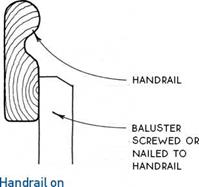
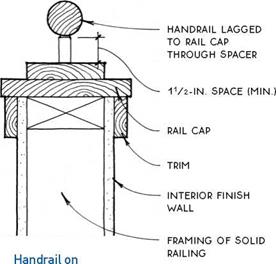
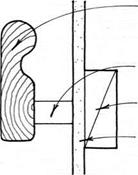

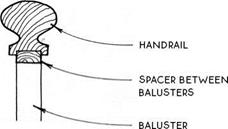
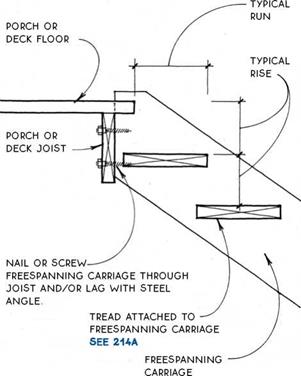 Most exterior wood stairs are freespanning. For long runs of stairs, the continuous unnotched carriage is usually required for strength (see 222B & D). Short runs of freespanning stairs may be strong enough with a notched carriage (see 222C). The notched carriage is, of course, also suitable for wood stairs built between two parallel concrete or masonry walls.
Most exterior wood stairs are freespanning. For long runs of stairs, the continuous unnotched carriage is usually required for strength (see 222B & D). Short runs of freespanning stairs may be strong enough with a notched carriage (see 222C). The notched carriage is, of course, also suitable for wood stairs built between two parallel concrete or masonry walls.

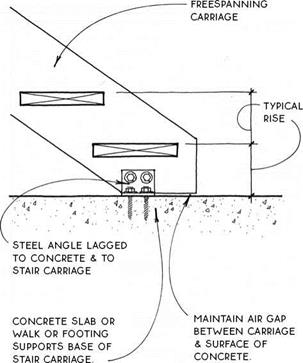


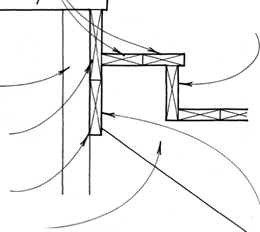 RiM JOiST OF PORCH
RiM JOiST OF PORCH

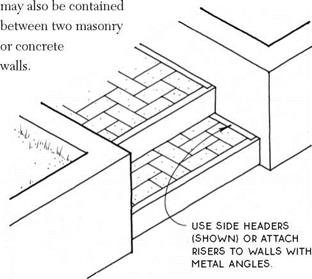


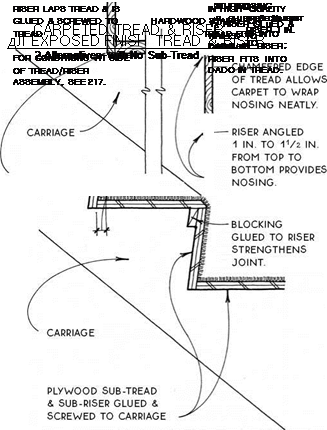
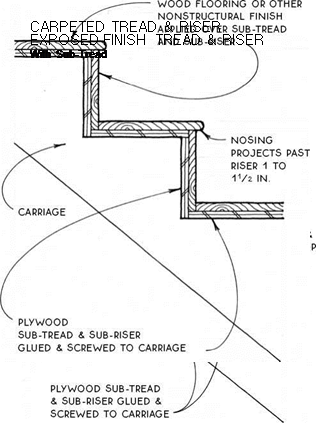



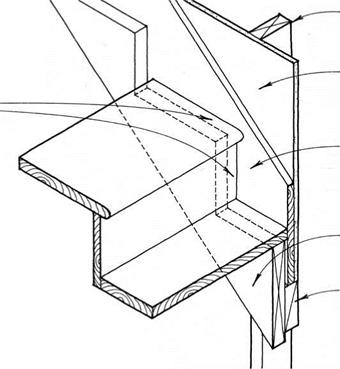


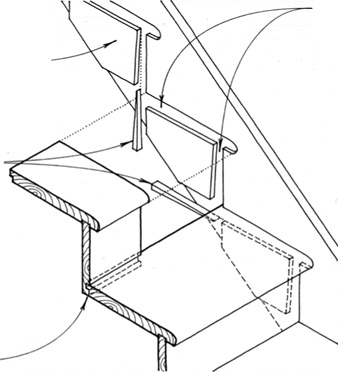

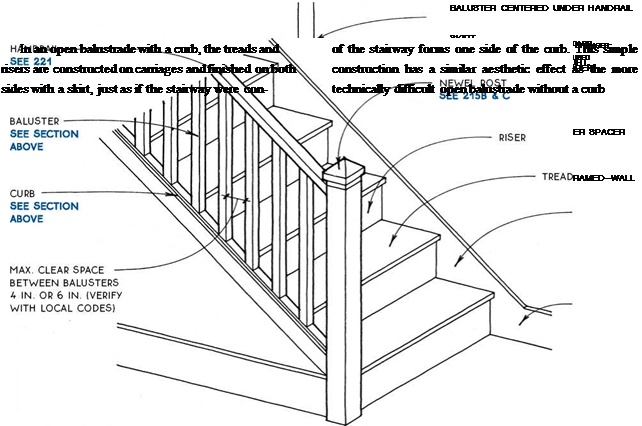
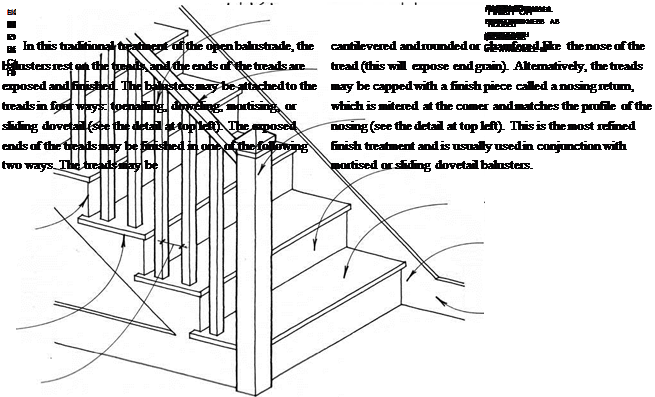





 The closed balustrade is veiy economical to build because it involves the least finish work of any balustrade system. The balustrade is framed like a standard wall (except that the base must be anchored like a newel post to resist lateral forces (see 215B). The stairway may be finished simply on both sides with finish stringers.
The closed balustrade is veiy economical to build because it involves the least finish work of any balustrade system. The balustrade is framed like a standard wall (except that the base must be anchored like a newel post to resist lateral forces (see 215B). The stairway may be finished simply on both sides with finish stringers.


